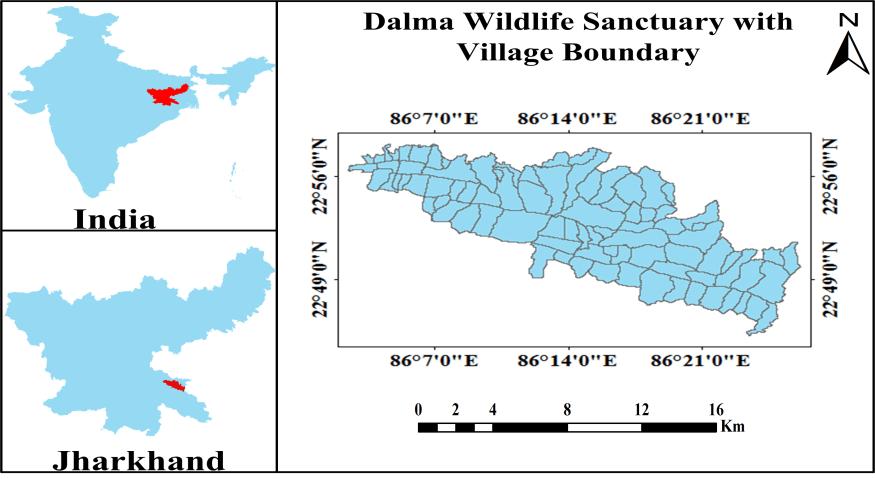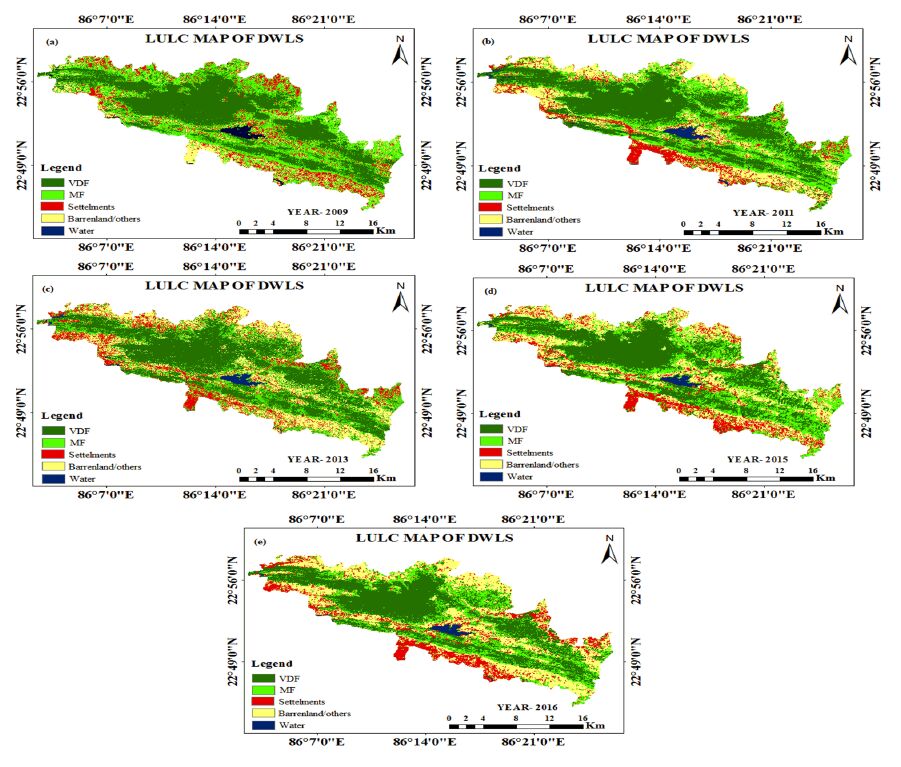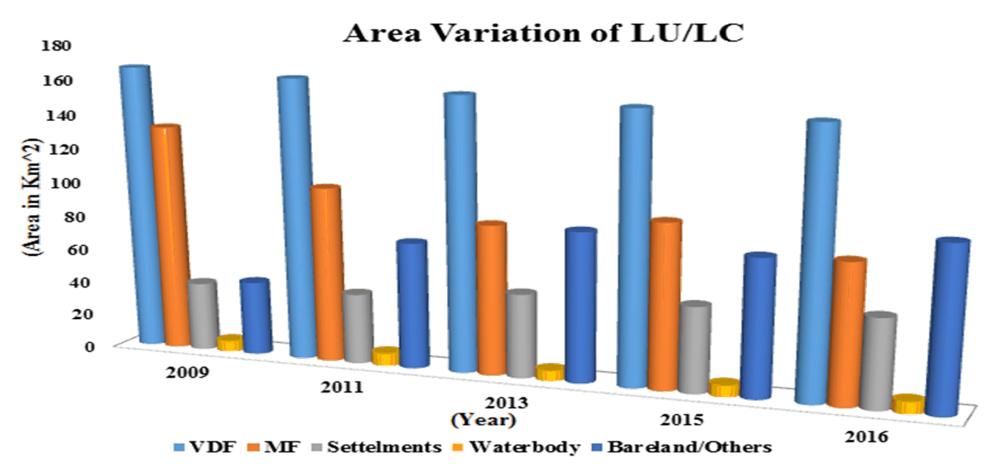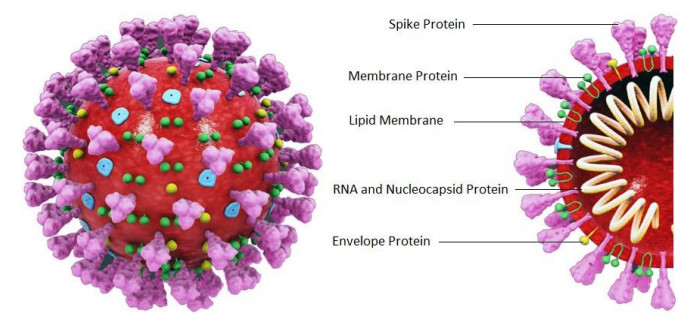1. Introduction
Geo-informatics technology or 3S technology stands for integration of Remote Sensing (RS), Geospatial Information System (GIS) and Global Positioning System (GPS). Present-day 3S technology is proving as most dynamic and innovative tool for environmental researcher and geo-scientist for mapping, monitoring, modelling, assessment and defensible management of various environmental issues and natural resources by its specific capabilities and cost effectiveness [1]. Assessment of LU/LC variations is feasible using GIS techniques if the subsequent spatial datasets of different scales or resolutions are available [2]. Land use land cover is an important component to understand global land status; it shows present as well as past status of the Earth’s surface. Land use and land cover are two distinct terms which are often used interchangeably. In common, land cover is defined as the perceived (bio)-physical cover on the Earth’s surface which may include vegetation, man-made features, bare rock, bare soil, and inland water surfaces, etc. Land use denotes the approach in which land has been used by humans for economic activities [3,4,5,6]. LU/LC is the basic parameter which evaluates the composition of Earth’s surface to monitor the condition and functioning of the ecosystem. LU/LC variations caused by natural and human resources have generally resulted in deforestation, global warming, biodiversity loss and increase of natural disaster-flooding [7,8,9,10]. LU/LC data sets are the primary inputs for environmental modelling and monitoring, carbon cycle studies, hydrology and global climate change analysis, natural resources management, policy-making, etc. [11]. The LU/LC monitoring includes tracking the changes of a natural environment and their influence on the ecosystem [12].
There are numerous methods established in literature for LU/LC change detection: post classification comparison, image ratio, image regression, orthodox image variation and manual on-screen digitization of multi temporal satellite imagery [7]. It is a well known fact that post classification comparison is the most precise technique which has the advantage of indicating the nature of the changes [11]. In present research, change detection comparison (pixel by pixel) method was adopted to the Land use/Land cover maps obtained from satellite imagery. Many researchers from diverse countries have recognized the advantages of geospatial technology in mapping, monitoring and detecting LU/LC variation. For example Prakasam (2010) analyzed LU/LC change using Landsat and IRS image data in Kodaikanal Taluk, Tamil Nadu and found that forest degraded up to 50% in 2008. While N. Kayet and K. Pathak (2015) revealed that Very Dense Forest (VDF) area of Saranda forest, Jharkhand reduced to 8.61% and Open Forest (OF) increased to 7.03% between the years 1992 and 2014 due to increase in built-up area and mining activity. In West Java, Kaswanto et al. (2010) analyzed the impact of LU/LC changes on spatial pattern of landscape between two decades (1989-2009) using Landsat Imagery and detected the changing of forest and grassland into agricultural and built-up area. Mengistu and Salami (2007) studied the LU/LC change detection using Landsat imagery in a region of south western Nigeria and they revealed that forest area has decreased and a corresponding increase is noticed in shrub land/farmland complex and settlement/bare surface [7]. An assessment of variation in forest cover has become a vital element in the present-day system for management of natural resources and identifying environmental deviations [5].
Many of recent researches has publicized that the overpowering population pressure, practicing unscientific cultivated methods and the lack of consciousness about the significance of forests among the people are the key reasons for deforestation/degradation of forest [6]. Jharkhand has geographical area of 79, 714 Km2 contributing 2.42% of the country's area. The total noted forest area of the state is 23, 605 Km2 which is 29.61% of the geographic area of the state. Reserved forests area establishes 18.58%, protected forests area 81.28%, and unclassified forests area covers 0.14%. The total forest and tree cover area set together, establishes about 32.48% of the geographic area of the state compared to the national average of 23.81% [13,15]. DWLS also plays an active part towards maintaining the state's ecological condition by its large forest area which is spread out over 193.22 Km2. Various habitats inhabited by diverse wildlife species are essential for maintaining the ecological balance and global carbon cycle equilibrium [13]. The present investigation reports the variation in LU/LC due to increment in shifting cultivation, forest fire, built-up area, etc. Also an attempt has been taken to establish a relation between decrease in forest cover area with increase in built-up area, agricultural land or bare land by multi temporal satellite imagery of DWLS.
1.1. Investigated field
The Dalma Wildlife Sanctuary, Jamshedpur which is spatially located between Latitudes 22°46’30” and 22°57’ N and Longitudes 86°3’15” and 86°26’30” E in the East Singhbhum and Sariakela-Kharsawan districts of Jharkhand and spread out over an area of 193.22 Km2 covering 86 villages are shown in Figure 1. DWLS was inaugurated by Late Sanjay Gandhi in 1975 and sanctuary
was acquainted by Government of Bihar vide gazette notification number S.O 1221 dated 17 July1976 [13]. It has a distinct Eco-sensitive Zone to shield the forest area. Forest renews the ground water aquifer by storing rainfall and protects streams against siltation by minimizing soil erosion. DWLS is so compact that visibility reduces to just 15 feet, it carries a diverse habitat for different Wildlife Species, and it is rich in vegetation containing various species of plant and trees with 90% of timber [16]. Ramgarh and Saharbera are selected for exploration of forest degradation due to illegal settlement encroachment in forest reserve area, which is geographically located in south west (SW) of the sanctuary nearby the National Highway-32 (NH). Increase in the population and NH construction has its consequence in the forest area getting decreased [13,16].
1.2. Materials and data used
The five sets of temporal remote sensing data used for current study include: LISS-III (2009, 2011 & 2013), Landsat-TM (2015, 2016) and Topographic maps of scale 1:50, 000. Five different year’s satellite data were collected from BHUVAN and United State Geological Survey (USGS) [17,18], where these data are freely available, and topographic maps were downloaded from India and Pakistan AMS topographic maps [19]. Care is taken to ensure that the data was cloud free and does not belong to leafless season. The details of the used satellite data are presented in Table 1. Shapefile of DWLS with village boundary and Pillars, GPS Coordinates of two villages, Ramgarh and Saharbera were provided by the Administration of DWLS.
Table 1. Data used in present investigation
| Year | Satellite date | Resolution | Data source |
| 2009 | LISS-Ⅲ | 23.5m | BHUVAN |
| 2011 | LISS-Ⅲ | 23.5m | BHUVAN |
| 2013 | LISS-Ⅲ | 23.5m | BHUVAN |
| 2015 | LANDSAT-TM | 30m | USGS |
| 2016 | LANDSAT-TM | 30m | USGS |
2. Methodology
ArcMap-10 and Erdas Imagine-9.2 software’s have been preferred for current study to prepare the LU/LC variation maps, using multi-temporal satellite data and toposheet. Different steps have been followed in present investigation as shown in Figure 2. The all-encompassing image
processing procedure was done by using ERDAS IMAGINE and ArcMap software. Layer stacking of individual band in image file and georeferencing were completed by ERDAS IMAGINE-9.2; False Colour Composite (FCC) creation and further image classification were accomplished by using ArcMap-10 [12].
2.1. Image classification
In supervised classification, Maximum Likelihood Classification (MLC) technique was adopted in present study to analyze the variation in LU/LC of DWLS in five different years. The maximum likelihood classifier takes up the pixels of unknown class membership and decides certain possibility of going to a specific category [20]. The probabilities in MLC technique are the same for all the classes and the input signatures in each band follows the Gaussian distribution function to classify the image [21]. The supervised classification involves training areas for every category and the training area is used to express spectral reflectance patterns/signature of each LU/LC category. The signatures would then be used by classifier to group the pixels into a certain category which has the same spectral patterns [20,21]. The number of the test points/pixels was derived based on the thumb rule that these should at least ten times the total number of classes. As there are five LU/LC classes so the total sample size was computed to be 5*10*5=250 pixels, and the number of pixels for each class was determined by using ratio calculation. All the five LU/LC classes were assigned a rank in the ascending order of their area, each rank was divided by the sum of the ranks, i.e. 15, and finally it was multiplied by the total number of pixels, i.e. 250 as shown in Table 2. The training sample was collected on-screen.
Table 2. Sample size of test point for accuracy assessment
| LU/LC Classes | Rank | Sample Size |
| VDF | 1 | 1/15*250=16.67 |
| MF | 2 | 2/15*250=33.33 |
| SETTELEMENTS | 4 | 4/15*250=66.67 |
| WATERBODY | 5 | 5/15*250=83.33 |
| BARELAND/OTHERS | 3 | 3/15*250=50 |
| TOTAL | 15 | 250 |
3. Results and Discussion
Infringed zones inside the forest diverge in shape and size. It is comparatively easier to identify the larger extension of encroached pockets. In several cases, encroachers often plant non-forest trees in the gaps and in nearby small herbs and shrubs to have their right on their encroached land. In such cases, it is difficult to identify the encroachment with remote sensing images due to little background contrast in such environment. It is important to mention that in the absence of digitized boundaries of recorded forest area; it is bit difficult to indicate changes in forest-cover within and out-side of the small forest areas. Similarly, the absence of digitized boundaries of revenue villages also leads to confusion in the detection of forest encroachment. Also, it is difficult to validate encroachments using toposheets as they are not frequently updated by the concerned agencies. In such cases, validation is done through multi temporal satellite imagery, interviews, field visits, perceiving forest agency records and taking GPS/DGPS readings [22,23,24,25,26].
With the help of multi temporal satellite data of five years, supervised classification (Maximum Likelihood Classification) technique has been adopted which works based on the similar reflectance appearance of altered LU/LC classes. It is observed from the prepared map that the area of VDF has gradually decreased; in 2009 VDF area was 166.57 Km2 which is decreased to 164.30 Km2 in 2011, likely VDF area regularly decreased to 159.43Km2, 156.75 Km2 and 154.13Km2 approximately in 2013, 2015 and 2016 respectively as presented in Figure 3. Degradation of VDF and Moderate Forest (MF) area in the year of 2011-2013 was very high that contributes 4.87 and 15.04 Km2 respectively which belong to 1.26% & 3.86% of the total VDF and MF area. It is due to drastic increment in settlement and bare land/ others area which are 7.82 & 13.46 Km2 respectively. Similarly in the year range of 2009-2011, 2013-2015 and 2015-2016 VDF area got degraded by 0.59%, 0.68% and 0.67% incessantly, which corresponds to degradation of 2.27 Km2, 2.68 Km2 and 2.62 Km2 of the VDF area respectively. MF also gradually decreased since last 7 years, but in the year of 2015 there is a sudden raise by 2.13% in comparison to 2013 (This drastic change may be due to classification error or due to seasonal variation in vegetation) as presented in Table 3.
Table 3. LU/LC variations over the years
| LU/LC CLASS | 2009 | 2011 | 2013 | 2015 | 2016 |
| Area | Area | Area | Area | Area | Area | Area | Area | Area | Area |
| (Km2) | (%) | (Km2) | (%) | (Km2) | (%) | (Km2) | (%) | (Km2) | (%) |
| VDF | 166.57 | 42.80 | 164.30 | 42.20 | 159.43 | 40.94 | 156.75 | 40.26 | 154.13 | 39.56 |
| MF | 132.68 | 34.10 | 102.54 | 26.33 | 87.49 | 22.47 | 95.76 | 24.60 | 81.126 | 20.84 |
| SETTELEMENTS | 40.16 | 10.31 | 41.23 | 10.59 | 49.05 | 12.60 | 50.06 | 12.85 | 52.01 | 13.36 |
| WATERBODY | 6.39 | 1.64 | 7.44 | 1.91 | 6.05 | 1.55 | 6.719 | 1.72 | 6.966 | 1.78 |
| BARELAND/OTHERS | 43.37 | 11.14 | 73.86 | 18.96 | 87.32 | 22.43 | 80.01 | 20.55 | 95.02 | 24.41 |
During the degradation assessment of reserve forest area of sanctuary with respect to previous time period, it is observed that forest degradation is steadily taking place due to various causes like shifting cultivation, forest fire, cutting of trees to fulfil basic needs of local habitants, increment in settlement area, conversion of forest area into crop land/ bare land etc. Throughout the whole investigation of last 7 years from 2009-2016 it is noted that VDF area of DWLS is gradually diminishing at the rate of 0.46% that is 1.77 Km2 per year of total area. Whereas settlements and bare land/others are steadily increasing at the rate of 0.44% & 1.89% which are 1.69 Km2 and 7.37 Km2 per year of total forest cover area. Water body within the DWLS is approximately constant in all the years as shown in Figure 4. According to current case study it has been revealed that the deforestation is taking place gradually due to several concerns as we have discussed earlier, which is not optimistic indication for ecological equilibrium.
To establish a relation between the humiliation of forest cover and increment in settlement area/bare land, two selected villages viz. Ramgarh and Saharbera were surveyed with prior GPS coordinates of the reserved forest boundary. During the traditional field survey it is noted that lots of pillars were ruined or illegally dislocated by the local habitants for making their own shelters or using it as an agricultural land etc. which is validated in Figure 5. Pillars location with prior and examined position has been also listed with loss of forest cover distances in Table 4 and 5 for the two selected villages. Minus marks (-) in Table 4 and Table 5 shows the loss of distance (approximately) from the prior pillars location (only negative variation of Pillars ID has been listed).
Table 4. Geographic coordinates with pillars ID and distance of Ramgarh villages
| Pillars ID | Examined GPS Coordinates (Degree, Minute, Second) | Prior GPS Coordinates (Degree, Minute, Second) | Variation in Pillars Distance (m) |
| 1 | 86 09' 09.0'' E 22 53' 08.6'' N | 86 9'8.97"E 22 53'9.287"N | -21.151802 |
| 3 | 86 09' 17.1'' E 22 53' 06.3'' N | 86 9'12.071"E 22 53'9.799"N | -70.764403 |
| 4 | 86 09' 22.8'' E 22 53' 04.6'' N | 86 9'17.078"E 22 53'7.968"N | -52.270414 |
| 5 | 86 09' 26.3'' E 22 53' 04.0'' N | 86 9'22.786"E 22 53'6.662"N | -18.493981 |
| 7 | 86 09' 33.5'' E 22 53' 03.9'' N | 86 9'29.935"E 22 53'5.493"N | -3.100787 |
| 8 | 86 09' 35.5'' E 22 53' 03.8'' N | 86 9'33.487"E 22 53'5.773"N | -3.000650 |
| 11 | 86 09' 41.0'' E 22 53' 03.5'' N | 86 9'41.127"E 22 53'4.738"N | -12.335158 |
| 14 | 86 09' 57.7'' E 22 53' 06.0'' N | 86 9'51.837"E 22 53'8.086"N | -55.371204 |
| 15 | 86 09' 58.8'' E 22 53' 04.6'' N | 86 9'57.761"E 22 53'6.031"N | -43.078794 |
| 16 | 86 10' 02.4'' E 22 53' 03.8'' N | 86 9'58.86 "E 22 53'4.603"N | -24.695555 |
| 18 | 86 09' 09.0'' E 22 53' 08.6'' N | 86 9'8.97"E 22 53'9.287"N | -21.151802 |
Table 5. Geographic coordinates with pillars ID and distance of Saharbera villages
| Pillars ID | Examined GPS Coordinates (Degree, Minute, Second) | Prior GPS Coordinates (Degree, Minute, Second) | Variation In Pillars Distance (m) |
| 26 | 86 07' 35.8'' E 22 53' 46.6'' N | 86 7' 35.62"E 22 53' 46.651"N | -5.36 |
| 53 | 86 07' 5.7" E 22 53' 26.3"N | 86 6' 55.873"E 22 53' 29.852"N | -87.837663 |
| 54 | 86 07' 8.4" E 22 53' 25.6"N | 86 6' 59.341"E 22 53' 29.027"N | -56.218106 |
By analysing the above listed prior and examined GPS coordinates it can be predicted that forest area is diminished by human influences to fulfil their needs, so it is very important to protect the forest environment and maintain the ecological balance.
4. Accuracy assessment
The accuracy assessment is essential to validate the of image classification results and a number of methods have been developed for this process. For accuracy assessment validation, a confusion matrix has been prepared with the help of classified and pre classification satellite imagery [27], using a sample of 10 randomly selected pixels within each class that were collected on-screen by an experienced interpreter. The results show that the overall accuracy of five LU/LC datasets for the years 2009, 2011, 2013, 2015 and 2016 was 91.48, 95.00, 95.00, 92.59 and 85.37 respectively as shown in Table 6.
Table 6. Confusion matrix over the years for LU/LC
| (A) Year- 2009 |
| LU/LC Class | VDF | MF | Waterbody | Settlement | Bareland/Others | Total | User’s Accuracy (%) |
| VDF | 7 | 1 | 0 | 0 | 0 | 8 | 87.5 |
| MF | 3 | 8 | 0 | 0 | 0 | 11 | 72.73 |
| Waterbody | 0 | 0 | 8 | 0 | 0 | 8 | 100 |
| Settlement | 0 | 0 | 0 | 10 | 0 | 10 | 100 |
| Bareland/ | 0 | 0 | 0 | 0 | 10 | 10 | 100 |
| Others | | | | | | | |
| Total | 10 | 9 | 8 | 10 | 10 | 47 | |
| Producer’s Accuracy(%) | 70 | 80 | 80 | 100 | 100 | | |
| Overall Accuracy (%) | | | | | | | 91.48 |
| (B) Year- 2011 |
| LU/LC Class | VDF | Waterbody | MF | Bareland/Others | Settlement | Total | User’s Accuracy (%) |
| VDF | 10 | 0 | 0 | 0 | 0 | 10 | 100 |
| Waterbody | 0 | 10 | 0 | 0 | 0 | 10 | 100 |
| MF | 0 | 0 | 9 | 0 | 0 | 9 | 100 |
| Bareland/ | 0 | 0 | 0 | 9 | 0 | 9 | 100 |
| Others | | | | | | | |
| Settlement | 0 | 0 | 1 | 1 | 10 | 12 | 83.33 |
| Total | 10 | 10 | 10 | 10 | 10 | 50 | |
| Producer’s Accuracy(%) | 100 | 100 | 90 | 90 | 100 | | |
| Overall Accuracy (%) | | | | | | | 95.00 |
| (C) Year- 2013 |
| LU/LC Class | VDF | MF | Waterbody | Settlement | Bareland/Others | Total | User’s Accuracy (%) |
| VDF | 10 | 0 | 2 | 0 | 0 | 12 | 83.33 |
| MF | 0 | 10 | 0 | 0 | 0 | 10 | 100 |
| Waterbody | 0 | 0 | 8 | 0 | 0 | 8 | 100 |
| Settlement | 0 | 0 | 0 | 10 | 0 | 10 | 100 |
| Bareland/ | 0 | 0 | 0 | 0 | 10 | 10 | 100 |
| Others | | | | | | | |
| Total | 10 | 10 | 10 | 10 | 10 | 50 | |
| Producer’s Accuracy(%) | 100 | 100 | 80 | 100 | 100 | | |
| Overall Accuracy (%) | | | | | | | 95.00 |
| (D) Year- 2015 |
| LU/LC Class | VDF | Waterbody | MF | Bareland/Others | Settlement | Total | User’s Accuracy (%) |
| VDF | 10 | 0 | 0 | 0 | 0 | 10 | 100 |
| Waterbody | 0 | 10 | 0 | 0 | 0 | 10 | 100 |
| MF | 0 | 0 | 9 | 2 | 0 | 11 | 81.82 |
| Bareland/ | 0 | 0 | 0 | 8 | 0 | 8 | 100 |
| Others | | | | | | | |
| Settlement | 0 | 0 | 1 | 0 | 10 | 11 | 90.91 |
| Total | 10 | 10 | 10 | 10 | 10 | 50 | |
| Producer’s Accuracy(%) | 100 | 100 | 90 | 80 | 100 | | |
| Overall Accuracy (%) | | | | | | | 92.59 |
| (E) Year- 2016 |
| LU/LC Class | VDF | MF | Waterbody | Settlement | Bareland/Others | Total | User’s Accuracy (%) |
| VDF | 10 | 0 | 0 | 0 | 0 | 10 | 100 |
| MF | 0 | 6 | 1 | 0 | 0 | 7 | 85.71 |
| Waterbody | 0 | 4 | 9 | 0 | 1 | 14 | 64.29 |
| Settlement | 0 | 0 | 0 | 10 | 0 | 10 | 100 |
| Bareland/ | 0 | 0 | 0 | 0 | 9 | 9 | 100 |
| Others | | | | | | | |
| Total | 10 | 10 | 10 | 10 | 10 | 50 | |
| Producer’s Accuracy(%) | 100 | 60 | 90 | 100 | 90 | | |
| Overall Accuracy (%) | | | | | | | 85.37 |
5. Conclusions
The investigation apparently predicts the reason behind the gradual loss in forest cover area of DWLS from the study of multi-temporal satellite imageries of last seven years since 2009-2016 as well as from the field visit experience. Main causes for the loss of forest area assessed from field verification and interacting with local villagers are as follows; shifting cultivation, forest fire, settlement infringement, conversion of forest area into crop land/ bare land etc. With the help of In-situ data and remotely sensed data it has been analyzed that VDF area is decreasing at the rate of 1.77 Km2 per year and settlement/bare land is increasing at the rate of 1.69 Km2, 7.37 Km2 respectively per year of total area which is not positive indication for ecological equilibrium. The foremost variations in the LU/LC through the study retro amongst the years 2009, 2011, 2013, 2015 and 2016 are recorded which provided us with stimulating explanation.
Acknowledgements
Authors are grateful to Ministry of Environment and Forests, Jharkhand Wildlife for authorization to work in Dalma Wildlife Sanctuary. Authors also thank to Mr. Kamlesh Pandey, Divisional Forest Officer (DFO), Dalma Wildlife Sanctuary Jamshedpur, for kind support. We are pleased to GIS analyst of Jamshedpur Mr. Balram Yadav, for going through the manuscript and providing their valuable comments, suggestions and appreciation to improve this manuscript. We would like to express sincere thanks to Forest guard Kaleshwar Mahto and many staffs of DWLS for their help and support during the field work.
Conflict of Interest
All authors declare no conflict of interest.










 DownLoad:
DownLoad: 












